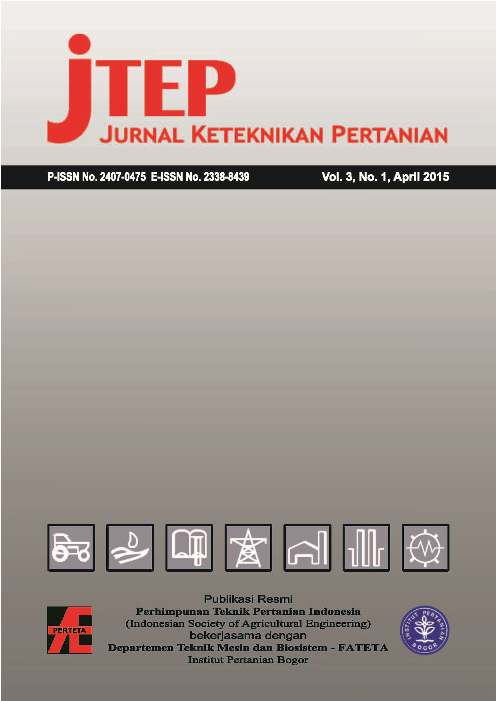Studi Gerak Kerja Pemanenan Kelapa Sawit Secara Manual
Abstract
Abstract
Good harvesting technique and timing is necessary to result good productivity in oil-palm industies. The harvesting activity is mostly conducted by ‘human powered’ manual handling which quite arduous and risky in term of work safety and musculoskeletal disorders (MSD). This research deals with anthropometry and motion study to analyse manual harvesting activity in oil palm plantation so the activity can be done in more safety, efficient and productive. Motion study using Natural Range of Motion (ROM) is applied to know the level of motion risk based on ROM indeks and appropriate antropometry. Manual harvesting tasks by using
conventional tools named ‘dodos’ and ‘egrek’ were studied in this research. The aims of this research is to know the pattern and risks distribution of the work motions, and then to determine a good harvesting
procedure to minimize the risk. The anthropometry result show that the harvester posture is ideal and uniform. The ‘cutting with egrek (CuE)’ was found as the most risky work element in the manual harvesting
task, and the MSD risks occur on the neck, shoulder, forearm, back and ankle.Such work procedures should be designed and appropriate working distance and length of tool are required to prevent the risks. Work motion simulation revealed that 1.5, 2.5, 5.5, and 8.5 mare suitable working distance to harvest 3, 6, 12 dan 18 mheight of targeted bunches, respectively.
Keywords: ergonomic, manual harvesting, oil palm, motion study, anthropometry
Abstrak
Teknik dan waktu pemanenan yang tepat diperlukan untuk mencapai produktivitas yang baik di industri kelapa sawit. Kegiatan panen sawit secara umum masih dilakukan secara manual mengandalkan tenaga
manusia yang tergolong cukup sulit dan beresiko tinggi dalam hal keselamatan kerja dan gangguan muskuloskeletal (MSD). Tujuan dari kajian ini adalah untuk menganalisis kegiatan panen-muat kelapa sawit di beberapa perkebunan sawit dengan pendekatan ergonomi dan mekanisme kerja yang optimal, baik dari sudut pandang efektivitas maupun keselamatan kerja. Lingkup yang dikaji dalam kajian ini adalah
berfokus pada analisis antropometri serta gerak kerja pemanenan dengan pendekatan selang gerak alami (natural Range of Motion: ROM). Kajian ini juga meliputi dua metode dan alat panen yang lazim digunakan, yaitu ‘dodos’ dan ‘egrek’. Hasil analisis antropometri secara umum menunjukkan bahwa pemanen di ketiga lokasi memiliki karakteristik postur tubuh yang relatif sama. Analisis gerak membuktikan bahwa elemen kerja yang terkait pemotongan tandan buah segar (TBS) memiliki resiko yang lebih tinggi dibandingkan dengan elemen kerja yang terkait dengan evakuasi dan pengumpulan TBS. Elemen kerja ‘cutting egrek
(CuE)’ teridentifikasi sebagai pekerjaan paling beresiko, dimana segmen tubuh yang paling beresiko adalah leher, bahu, punggung-pinggang, lengan hingga pergelangan kaki. Desain ergonomis terkait prosedur dan
jarak kerja diperlukan untuk meminimasi resiko tersebut, dan hasil simulasi menunjukkan bahwa jarak kerja yang ideal dan aman untuk ketinggian target potong (TBS) 3, 6, 12 dan 18 m berturut-turut adalah 1,5, 2,5, 5,5 dan 8,5 m.
Kata Kunci : ergonomika, pemanenan manual, kelapa sawit, studi gerak, antropometri
Diterima: 02 Desember 2014 ; Disetujui: 24 Februari 2015
Authors
Authors submitting manuscripts should understand and agree that copyright of manuscripts of the article shall be assigned/transferred to Jurnal Keteknikan Pertanian. This work is licensed under a Creative Commons Attribution-ShareAlike 4.0 International License (CC BY-SA) where Authors and Readers can copy and redistribute the material in any medium or format, as well as remix, transform, and build upon the material for any purpose, but they must give appropriate credit (cite to the article or content), provide a link to the license, and indicate if changes were made. If you remix, transform, or build upon the material, you must distribute your contributions under the same license as the original.

